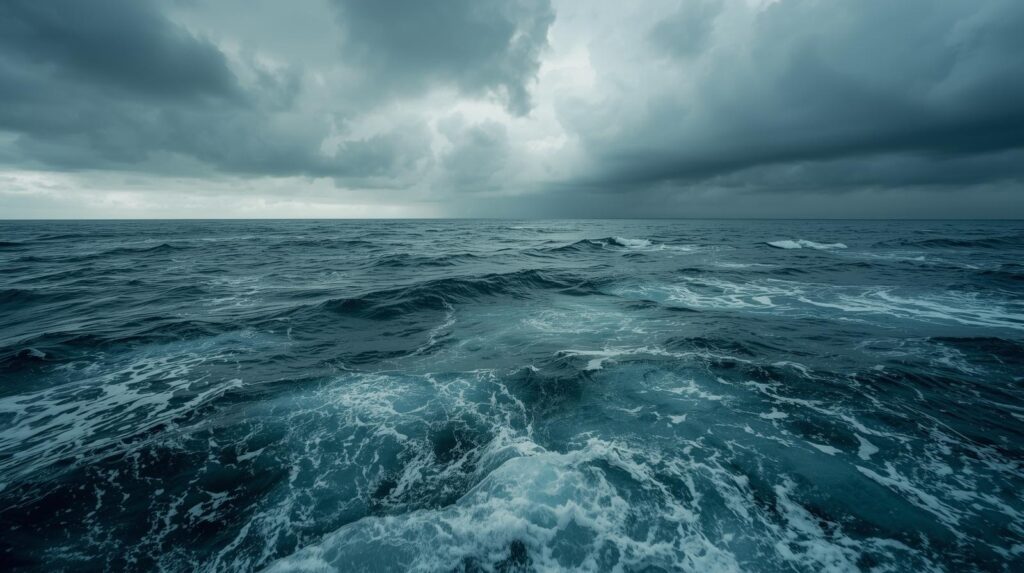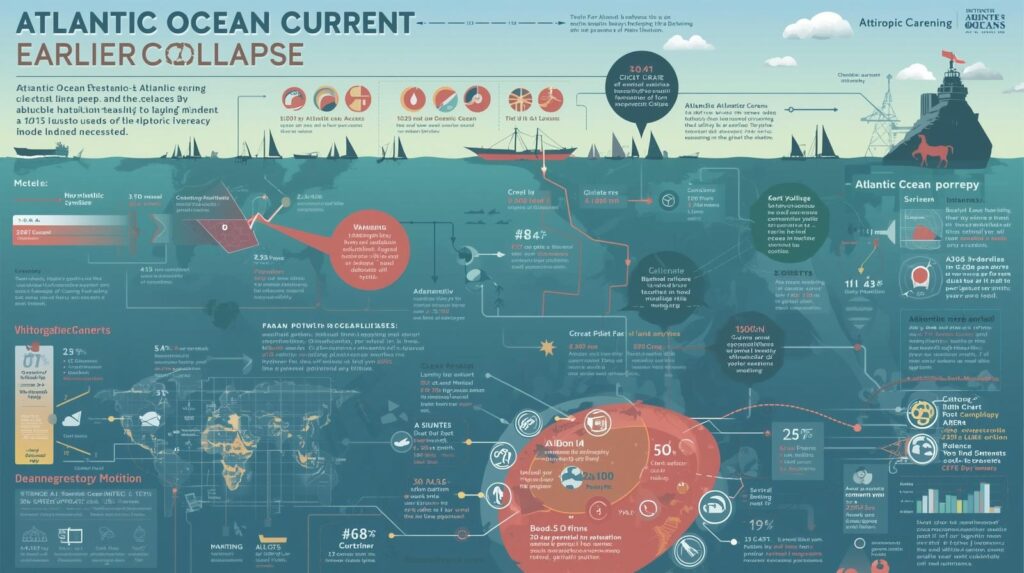Why Scientists Worry the Atlantic Ocean Current May Collapse Earlier Than Predicted
Envision a sea giant conveyor belt transporting warm water from the tropics to cold north and vice versa. Such a circulation, the Atlantic Meridional Overturning Circulation (AMOC), maintains mild weather for Europe, facilitates survival of fish, and influences the climate globally.
Researchers worry it is slowing down, and even stops, much faster than expected, maybe as early as 2025. Why? Human activities, such as burning gas and coal, are heating the Earth and disrupting ocean balance. A collapse can reverse weather patterns, increase sea levels, and wreak havoc on nature and humanity.
What Is the AMOC and Why Is It Important?
The Atlantic Ocean is a huge river in the ocean that comes all the way from the Atlantic. It brings warm, salty water from areas such as the Gulf of Mexico to the North Atlantic, near Greenland and Europe. As this water travels northward, it gets cooler, saltier due to evaporation, and denser. It sinks deep into the ocean and returns south, forming a loop. The cycle fetches round heat, nutrients, and oxygen, which makes the climate stable.

It’s a heat pump for Europe. Without the AMOC, Scandinavia and the UK would be colder, possibly even freezing like the Canadian provinces at the same latitude. It also brings rain to areas like Africa’s Sahel, a blessing for farmers planting crops to feed millions. It also maintains ocean health by moving nutrients needed by fish and other sea life.
Why Scientists Are Concerned a Collapse is Possible
Scientists actually knew years ago that the AMOC can slow down as the planet gets warmer, but new research indicates it may be closer to shutting down than previously thought—perhaps between 2025 and 2095, with some even predicting 2050. The issue begins with global climate change. Burning fossil fuels unleashes the heat-trapping greenhouse gases that heat up the ocean and melt ice in areas such as Greenland. That puts a huge burden of extra fresh water into the salty North Atlantic, which lightens the water so that it doesn’t sink as readily. That reduces the entire AMOC loop.
Observations and experiments indicate the AMOC is weaker today than it’s been in more than 1,600 years. Since the 1950s, it’s reduced its pace by about 15%, and some estimates say it’s weaker today than it was during ancient times when it entirely shut down. Scientists have witnessed initial warning signs, such as cooling spots in the North Atlantic and saltier water accumulating in the South Atlantic. These are similar to red flags, indicating the system destabilizes and could reach a tipping point, a point at which the system collapses and can’t be restarted easily
How Climate Change Disrupts the Atlantic Ocean
The temperature of the planet has increased around 1.3 degrees Celsius since factories and automobiles began emitting pollution. It doesn’t seem like much, but it has the ability to destabilize the AMOC. Here is why:
Melted Ice: Greenland’s ice sheet is melting violently, pouring billions of tons of new water into the North Atlantic annually. New water is denser than salty water, so it sinks that drives the AMOC. It’s like plugging a drain—the flow decelerates.
Warmer Oceans: Global warming warms surface water, which warms it up and makes it less dense and more reluctant to sink. This slows the conveyor belt’s circulation.
Increased Rain and Rivers: Global warming means more rain and runoff in the rest of the world, putting more fresh water into the ocean. This also upsets the salt balance required for the AMOC to function.
Scientists have observed that these changes are accelerating. For instance, scientists studied ocean warming from 1870 to 2020 and detected “early warning signals” that the AMOC is gaining instability. Another simulation, on supercomputers, that would occur if fresh water rises slowly, it revealed the AMOC would crash suddenly, perhaps in a few decades.

What Happens If the AMOC Halts?
If AMOC fails, its impact would be huge and worldwide. This is what would occur:
- Cold Europe: Europe would be much colder without the warm water moving north. Temperature drops of 10 to 30 degrees Celsius would be seen in some places. London, cold enough to be like the Arctic, with icy winters and shorter crop growing seasons, is just one example.
- Chaos Rain: The AMOC controls rain patterns. Shutting down would downscale Asian monsoons and the African Sahel region and reduce millions to compromised food supplies. Amazon’s wet and dry seasons would be reversed, devastating rainforests.
- Rising Seas: Water would accumulate along the U.S. East Coast if the AMOC closes down, flooding coasts by up to a meter. Cities of New York and Miami would experience increased flooding.
- Ocean Upheaval: AMOC disperses nutrients and oxygen to marine life. Its collapse would devastate fish, corals, and other marine animals, destroying fishing economies that provide food for millions.
- Increased Severe Weather: Temperatures would fluctuate wildly, with warmer tropics and cooler northern temperatures. Storms might get more intense, and weather patterns might shift in peculiar directions.
Those impacts wouldn’t just last for a year—whatever they do could potentially last centuries, because once the AMOC stops, it’s hard to restart. Scientists understand that it briefly shut down about 12,000 years ago during a period of warming, causing a cold snap that lasted over a thousand years known as the Younger Dryas. That was long before human settlements and agriculture, so the effect now would be much more severe.
Why the Timing Is So Alarming about Atlantic Ocean
What’s getting scientists particularly on edge is how fast this could happen. Previous studies estimated that during their earlier research, a collapse wasn’t going to happen prior to 2100, but the newer research indicates it could occur much sooner—possibly as soon as 2025 or by the 2030s. They took one of those records and utilized it to forecast a mid-century breakdown, and another simulated new new water shifts and determined that the AMOC could tip between 2037 and 2064. That timescale is frightening because it implies we may be able to witness big changes within our lifetime, not some distant time in the future.
The uncertainty is an issue as well. The AMOC has only been seen directly since 2004, so scientists make educated estimates based on factors such as ocean temperatures and salt levels. These are hints that it’s weakening, but it’s difficult to put your finger on when exactly it would stop. Some scientists believe that the models aren’t accounting for all the melting ice and that would make the collapse occur even sooner. Earth Science Education Exposed: An Interactive Overview of Curriculum and Learning
Where Scientists Identify Warning Signs
Scientists observe numerous signs to determine whether the AMOC is at risk. One significant sign is a cold spot in the North Atlantic, below Greenland. The region should be warm due to the direction of the AMOC flow, but it’s becoming chilly, indicating that the system is decelerating. Another indicator is the saltier water accumulating in the South Atlantic, which indicates that the conveyor belt isn’t circulating like it should. Scientists also look at ancient seafloor sediments to observe how the AMOC behaved thousands of years ago. Those findings verify that it can switch off in a snap when conditions shift, as they are currently doing.
Before another discovery is assisting too: researchers discovered that the volume of fresh water flooding in at the lower end, off South Africa, declines about 25 years before collapse. This would be an alert system, warning us if the AMOC is on its way toward a tipping point.
What a Collapse Would Mean for People and Places
A failing AMOC would affect people in a big way. In Europe, temperatures could be lower, making it hard to cultivate crops, increasing prices and leading to shortages. African and Asian farmers could not survive with reduced rainfall, impacting millions who depend on livestock or crops. Flooding in U.S. coastal cities could even be worse, making people have to rebuild or relocate. Marine ecosystem collapse would deprive fishing communities globally of their livelihood.
The cost to the economy would be enormous—billions in new infrastructure, relief from disasters, and acclimation to new climatic norms. The psychological damage would also be enormous, with communities being dislocated and uncertain. Even non-Atlantic areas, such as the tropics, might experience warmer temperatures and more intense storms, all making life more difficult for millions.
Can We Stop It?
The worst part: There’s still time to do something. Experts say that cutting down the pollution from fossil fuels is the largest solution to put on the brakes in slowing down the AMOC’s decline. Shifting to renewable energy, like solar and wind power, can slash the gases warming the world. Countries are already doing this—Europe’s encouraging more renewable energy, and some places are planting trees to soak up CO2.
We need better monitoring, too. Researchers are trying to monitor the AMOC more precisely, such as by tracking the movement of North Atlantic water. That might provide us with an improved signal if it’s going to switch. Preparing for the effects is vital, too—creating stronger coastal defenses, reshaping agriculture to cope with less rain, and safeguarding ecosystems.
We can do our part too. Save energy by turning off the lights, recycle, and vote for environmentally conscious leaders. Little efforts together, like riding buses rather than motorcars or eating less meat to curb pollution, go a long way. Countries united, like uniting on science and resources, can make a huge difference.
A Wake-Up Call for the Planet
Scientists are warning that the disintegration of the AMOC would change life as we know it. The notion that it could happen anytime soon—perhaps within a decade or two—is frightening, but it’s also an opportunity to act. Learning about how our behavior, such as fossil fuel combustion, is driving this critical ocean system to the brink, we realize why we must act quickly. It’s about protecting our weather, our food, and our homes. Every action taken in making our planet cleaner helps keep the AMOC flowing and our planet in check.
